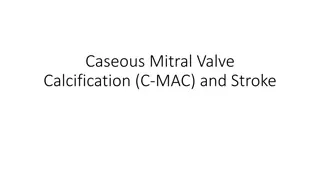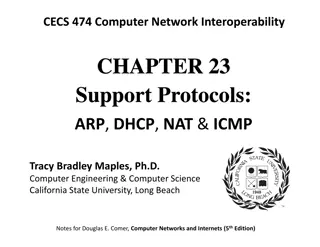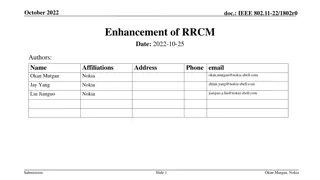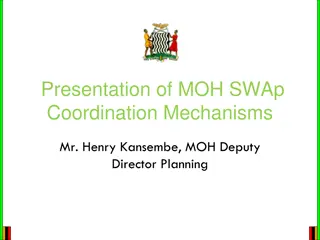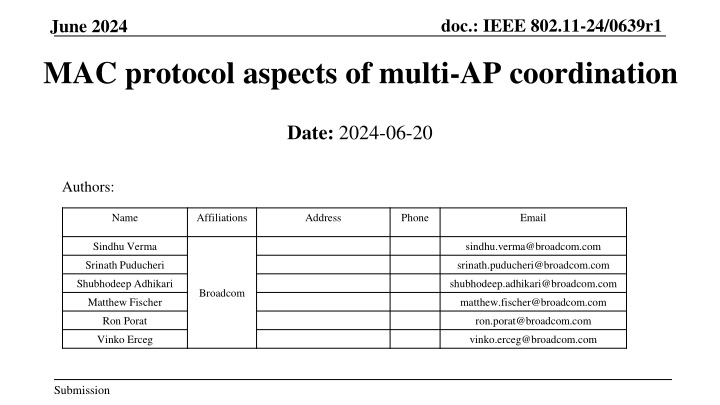
IEEE 802.11-24/0639r1 MAC Protocol Aspects of Multi-AP Coordination
Explore the MAC protocol aspects of Coordinated Beamforming (CBF) in IEEE 802.11-24/0639r1 for multi-AP coordination. The discussions cover simulation results and the extensibility to various coordination schemes, emphasizing the need for a common framework. Topics include AP discovery, candidate non-AP identification, sounding procedures, per-TXOP coordination, and initial AP discovery and configuration. The document also details the process of candidate non-AP identification in a coordinated multi-AP system.
Download Presentation

Please find below an Image/Link to download the presentation.
The content on the website is provided AS IS for your information and personal use only. It may not be sold, licensed, or shared on other websites without obtaining consent from the author. If you encounter any issues during the download, it is possible that the publisher has removed the file from their server.
You are allowed to download the files provided on this website for personal or commercial use, subject to the condition that they are used lawfully. All files are the property of their respective owners.
The content on the website is provided AS IS for your information and personal use only. It may not be sold, licensed, or shared on other websites without obtaining consent from the author.
E N D
Presentation Transcript
doc.: IEEE 802.11-24/0639r1 June 2024 MAC protocol aspects of multi-AP coordination Date: 2024-06-20 Authors: Name Affiliations Address Phone Email Sindhu Verma sindhu.verma@broadcom.com Srinath Puducheri srinath.puducheri@broadcom.com Shubhodeep Adhikari shubhodeep.adhikari@broadcom.com Broadcom Matthew Fischer matthew.fischer@broadcom.com Ron Porat ron.porat@broadcom.com Vinko Erceg vinko.erceg@broadcom.com Submission
doc.: IEEE 802.11-24/0639r1 June 2024 Abstract This contribution discusses MAC protocol aspects of Coordinated Beamforming (CBF) including simulation results. The protocol aspects are extensible to other multi-AP coordination schemes for all of which, it is desirable to have a common framework. Sindhu Verma, Broadcom Submission Slide 2
doc.: IEEE 802.11-24/0639r1 June 2024 Overview Step Operation Time-scale Details 1 AP discovery BSS setup, or new channel Identify peer CBF APs, capability-exchange CBF configuration (security, BSS color, etc.) 2 Non-AP STA identification Few 100ms - few seconds Identify candidate non-APs per-AP for CBF E.g., based on active DL traffic Could be limited to a few non-AP STAs across both APs (e.g., when in-BSS DL MU-MIMO is less likely). Exchange semi-static info common for multiple TXOPs (e.g., non-AP capabilities, AIDs, PPDU params) 3 Sounding ~ DL-MUMIMO sounding In-BSS and cross-BSS CSI acquisition 4 Per-TXOP coordination ~5ms Identify non-AP STAs to be serviced in current TXOP, Nss configuration - to identify/compute precoder. Exchange info needed for CBF PPDU construction (e.g., preamble and duration) Sindhu Verma, Broadcom Submission Slide 3
doc.: IEEE 802.11-24/0639r1 June 2024 Initial AP discovery and configuration At initialization or semi-statically, APs identify partner CBF APs within a coordinated multi-AP system: May explicitly poll each other or detect capabilities advertised by other APs (for e.g., in beacon frames, through centralized distribution of AP information to other APs, etc.) Candidate APs may perform a handshake to exchange various capabilities, such as: Number of Tx antennas/sounding dimensions/nulling capabilities supported by each AP Maximum number of candidate OBSS CBF clients supported by each AP: To manage/limit AP complexity (e.g., channel sounding, scheduling, etc) Following the above capability exchange and if CBF is chosen, the parameters corresponding to each of the capabilities are negotiated. The APs could configure the following joint parameters: Security keys for any protected messages that need to be received by partner CBF APs BSS color for CBF transmissions (for aligning the PHY preamble of the CBF PPDU) Etc. Sindhu Verma, Broadcom Submission Slide 4
doc.: IEEE 802.11-24/0639r1 June 2024 Candidate non-AP identification This occurs at a slow time-scale, e.g., 100s of ms APs identify a subset of non-APs likely to participate in CBF, for e.g., based on: Non-AP capabilities, Presence of active DL traffic, Etc. The APs exchange the following information between them AID of each candidate non-AP (e.g., for bookkeeping/identification) PHY capabilities of each candidate non-AP (e.g., operating bandwidth, max Rx Nss, etc.) The identified candidate non-APs are also notified of the configuration, e.g., other APs MAC address, the common BSS color, etc. This amounts to the setup of a CBF configuration at a non-AP Similar to the setup of a CBF configuration at a non-AP based on favourable capabilities and DL traffic conditions, there needs to be a mechanism for a CBF-teardown message exchange. This will tear down the existing CBF configuration at the non-APs currently operating within it when the conditions are no longer favorable Sindhu Verma, Broadcom Submission Slide 5
doc.: IEEE 802.11-24/0639r1 June 2024 Sounding This occurs at a time-scale similar to DL MU-MIMO APs acquire CSI from non-APs (in-BSS and cross-BSS). The additional overhead for performing CBF is only due to cross-BSS CSI There are multiple possible methods for this sounding operation. For example, Sequential, where feedback for each of the 2 APs is obtained from the non-AP one at a time Joint, where feedback for the 2 APs is obtained from the non-AP in a single report Sindhu Verma, Broadcom Submission Slide 6
doc.: IEEE 802.11-24/0639r1 June 2024 Per-TXOP coordination and frame exchange (1) Purpose: APs identify which non-AP STAs will be serviced in the current TXOP and exchange information needed for the CBF PPDU transmission. Participating APs need the following information prior to a CBF PPDU transmission: Which non-AP STAs will be serviced and corresponding per-STA Nss (to determine BF+nulling directions) TXOP duration, contents of the shared preamble of the CBF PPDU (e.g. puncturing, GI+LTF, # of LTFs, per- STA MCS, etc.) We propose a per-TXOP coordination that provides adequate flexibility to the participating APs: The shared AP communicates in a response frame to the sharing AP, the set of non-APs the shared AP wants to transmit to. This allows the shared AP some flexibility in selecting its non-APs based on queued traffic, QoS parameters, PHY parameters, etc. Exchange of non-AP MCS, Nss, etc between the sharing and shared APs, for correct nulling, construction of a common preamble, duration adjustment in the CBF PPDU. Using the control frame transmissions from both the sharing and shared AP to also notify participating non- APs in both BSSs of impending CBF data transmission in the TXOP, and potentially, enabling them to clear the medium in response. Sindhu Verma, Broadcom Submission Slide 7
doc.: IEEE 802.11-24/0639r1 June 2024 Per-TXOP coordination and frame exchange (2) TXOP MU-RTS / BSRP + AP2 notification SIFS SIFS SIFS SIFS SIFS CBF PPDU AP1 MU-RTS / BSRP + AP1 response CBF PPDU AP2 CTS / BSR TB-ACK AP1-STA CTS / BSR TB-ACK AP2-STA 1. AP1 initiates the TXOP with initial-control frame (ICF) addressed to AP1-STAs (e.g., MU-RTS/BSRP) and to AP2. Performs the usual functions of ICF (e.g., for EMLSR, etc.). Signals the possibility of CBF transmissions during this TXOP. Additionally, embeds AP2-notification to signal info needed by AP2 for CBF Can be contained in UserInfo fields with a special AID12 value. 2. AP1-STAs respond to ICF with ICR (e.g. CTS/BSR): When ICF frame signals CBF, AP1-STAs may not be serviced by AP1 immediately after they respond. Sindhu Verma, Broadcom Submission Slide 8
doc.: IEEE 802.11-24/0639r1 June 2024 Per-TXOP coordination and frame exchange (3) 3. AP2 transmits an ICF (a second control frame such as MU-RTS/BSRP) addressed to any candidate AP2-STAs it identifies for CBF (e.g., based on traffic), and to AP1. If AP2-STAs are addressed, performs the usual functions of an ICF. Additionally embeds AP1-response to signal response to AP1 Can be contained in UserInfo fields with a special AID12 value. 4. If any AP2-STAs are addressed by AP2 s ICF, they respond with an ICR (e.g. CTS/BSR). If no AP2-STAs are addressed and AP1-response reflects that AP2 cannot participate in CBF, AP1 initiates non-CBF transmission to AP1-STAs. 5. If AP2 indicates participation in CBF, then AP1 and AP2 initiate CBF PPDU transmission SIFS after the response from AP2-STAs. 6. SIFS after CBF PPDU, both APs STAs transmit their BAs respectively in a common TB PPDU (on separate RUs). Sindhu Verma, Broadcom Submission Slide 9
doc.: IEEE 802.11-24/0639r1 June 2024 Simulation Results for CBF performance Sindhu Verma, Broadcom Submission Slide 10
doc.: IEEE 802.11-24/0639r1 June 2024 Simulation Configuration Network topology: 2 APs (4x4) with 1 client (2x2) each Both APs are visible to each other Varying SNR between an AP and its client : SNR Varying interference I from one AP to the other APs client: SNR - X = I Bandwidth: 80MHz, Single Link Overheads modeled for per TXOP exchange : 24Mbps MU-RTS/CTS, MU-RTS with 0/64us padding Traffic types: DL traffic only: 1 flow per client, Full buffer The intent of this round of simulations is to evaluate the impact of per TXOP overheads Sindhu Verma, Broadcom Submission Slide 11
doc.: IEEE 802.11-24/0639r1 June 2024 Full Buffer DL throughput in Mbps with 0us MU-RTS padding Observations: CBF throughput gains over without CBF increase with increase in X. This happens as the CBF PHY rates increase with reduction in the relative interference from its partner CBF AP. Sindhu Verma, Broadcom Submission Slide 12
doc.: IEEE 802.11-24/0639r1 June 2024 Normalized Full Buffer DL throughput with 0us MU-RTS padding SNR (dB) X (dB) 35 30 25 20 15 10 0 1.21 1.24 1.31 1.32 1.72 1.60 5 1.33 1.29 1.37 1.32 1.74 10 1.39 1.35 1.40 1.31 With CBF 15 1.46 1.45 1.48 20 1.55 1.53 25 1.68 Without CBF 1.00 1.00 1.00 1.00 1.00 1.00 Sindhu Verma, Broadcom Submission Slide 13
doc.: IEEE 802.11-24/0639r1 June 2024 Normalized Full Buffer DL throughput with 64us MU-RTS padding SNR (dB) X (dB) 35 30 25 20 15 10 0 1.20 1.23 1.29 1.30 1.70 1.58 5 1.31 1.27 1.36 1.30 1.72 10 1.37 1.33 1.39 1.30 With CBF 15 1.44 1.43 1.47 20 1.53 1.51 25 1.66 Without CBF 1.00 1.00 1.00 1.00 1.00 1.00 Observations: Even with 64us padding overhead and the additional MU-RTS/CTS exchange, CBF continues to show significant gains Sindhu Verma, Broadcom Submission Slide 14
doc.: IEEE 802.11-24/0639r1 June 2024 Straw Poll Do you agree that TGbn shall define a Coordinated Beamforming and Nulling procedure as one variant of the Multi-AP topic? Sindhu Verma, Broadcom Submission Slide 15
doc.: IEEE 802.11-24/0639r1 June 2024 References [1] IEEE P802.11be /D6.0 [2] 11-23/0776r1 Performance of C-BF and C-SR Sindhu Verma, Broadcom Submission Slide 16
















